剧本 植物的自我保护 The Plants' Defense
植物如何自我保护英语作文
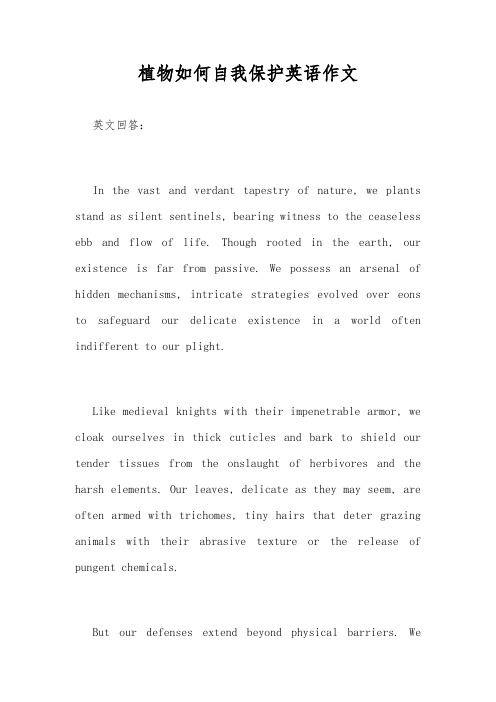
植物如何自我保护英语作文英文回答:In the vast and verdant tapestry of nature, we plants stand as silent sentinels, bearing witness to the ceaseless ebb and flow of life. Though rooted in the earth, our existence is far from passive. We possess an arsenal of hidden mechanisms, intricate strategies evolved over eons to safeguard our delicate existence in a world often indifferent to our plight.Like medieval knights with their impenetrable armor, we cloak ourselves in thick cuticles and bark to shield our tender tissues from the onslaught of herbivores and the harsh elements. Our leaves, delicate as they may seem, are often armed with trichomes, tiny hairs that deter grazing animals with their abrasive texture or the release of pungent chemicals.But our defenses extend beyond physical barriers. Wepossess an uncanny ability to communicate with one another, sending chemical signals through the air or the soil to alert neighboring plants of impending threats. This intricate network allows us to mount a collective defense, unleashing a symphony of scents and flavors that repel predators and attract beneficial insects.Furthermore, we have mastered the art of mimicry. Some of us adopt the guise of toxic or unpalatable species, donning similar coloration or exuding deceptive chemicals to ward off would-be attackers. Others mimic the appearance of insects or animals, using this clever ruse to deter herbivores or attract pollinators.Our survival instincts are not limited to external threats. We are also endowed with an arsenal of internal defenses. We produce an array of secondary metabolites, compounds that may not be essential for our growth but serve as potent deterrents to pests and pathogens. These chemicals can disrupt the digestive systems of herbivores, inhibit the growth of fungi, or even act as naturalantibiotics.As the seasons change, we exhibit remarkable resilience. Some of us shed our leaves in autumn, reducing our surface area and conserving energy during the harsh winter months. Others produce antifreeze proteins to survive the bitter cold, while some can even withstand the scorching heat of deserts.Our self-protective strategies are not merely instinctual reactions but the culmination of millions of years of evolutionary wisdom. They are a testament to our ability to adapt, innovate, and persevere in the face of countless challenges.中文回答:在自然界这片广袤葱郁的挂毯上,我们植物宛若沉默的卫士,见证着生命生生不息的潮起潮落。
我是绿植小卫士100字作文
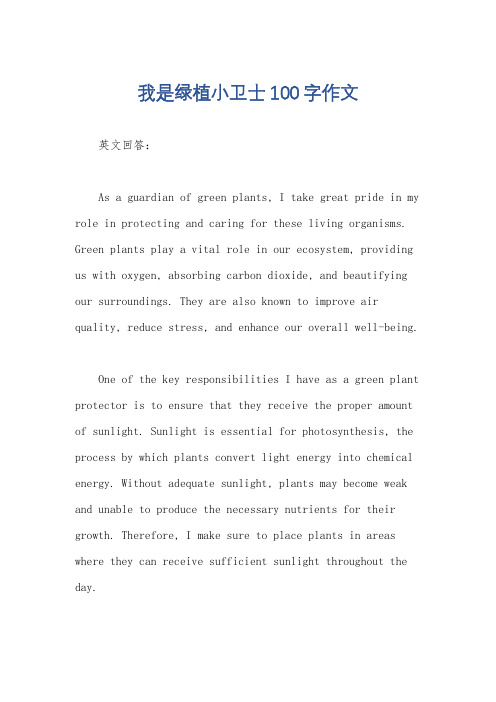
我是绿植小卫士100字作文英文回答:As a guardian of green plants, I take great pride in my role in protecting and caring for these living organisms. Green plants play a vital role in our ecosystem, providing us with oxygen, absorbing carbon dioxide, and beautifying our surroundings. They are also known to improve air quality, reduce stress, and enhance our overall well-being.One of the key responsibilities I have as a green plant protector is to ensure that they receive the proper amount of sunlight. Sunlight is essential for photosynthesis, the process by which plants convert light energy into chemical energy. Without adequate sunlight, plants may become weak and unable to produce the necessary nutrients for their growth. Therefore, I make sure to place plants in areas where they can receive sufficient sunlight throughout the day.Another important aspect of my role is to provide plants with the right amount of water. Overwatering or underwatering can both be detrimental to plants' health. Too much water can lead to root rot and other fungal diseases, while too little water can cause the plants to wither and die. I carefully monitor the soil moisturelevels and adjust the watering schedule accordingly. Additionally, I make sure to use filtered or distilled water to avoid any harmful chemicals or minerals that may be present in tap water.Furthermore, I regularly check for pests and diseases that may affect the plants. Common pests such as aphids, mealybugs, and spider mites can cause damage to the leaves and stems. To prevent infestations, I use organic pest control methods such as neem oil or insecticidal soap. Additionally, I keep a close eye on any signs of diseases such as fungal infections or viral infections. If detected, I take immediate action to treat the plants and prevent the spread of the disease.In addition to these basic responsibilities, I alsotake the time to prune and fertilize the plants. Pruning helps to promote healthy growth and shape the plants. It involves removing dead or diseased branches, as well as trimming back excessive growth. Fertilizing, on the other hand, provides plants with essential nutrients that may be lacking in the soil. I use organic fertilizers to ensure that the plants receive a balanced diet and thrive.Overall, being a green plant protector requires dedication, knowledge, and a genuine love for nature. It is a rewarding experience to see the plants flourish under my care and contribute to a healthier environment.中文回答:作为绿植的守护者,我为自己保护和照顾这些生命体的角色感到自豪。
幼儿园大班科学教案植物的自我保护
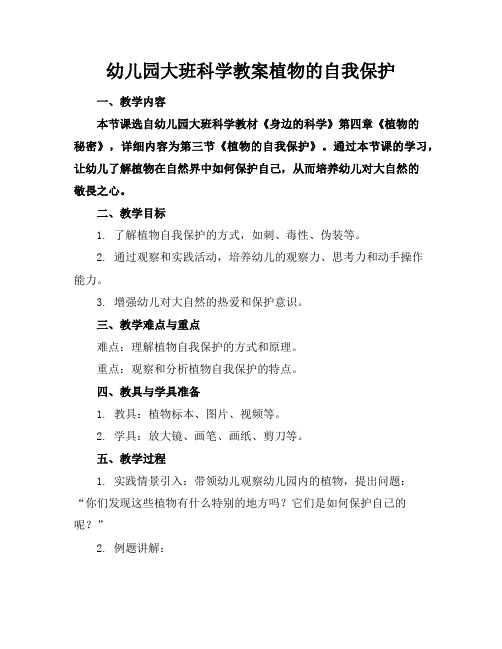
幼儿园大班科学教案植物的自我保护一、教学内容本节课选自幼儿园大班科学教材《身边的科学》第四章《植物的秘密》,详细内容为第三节《植物的自我保护》。
通过本节课的学习,让幼儿了解植物在自然界中如何保护自己,从而培养幼儿对大自然的敬畏之心。
二、教学目标1. 了解植物自我保护的方式,如刺、毒性、伪装等。
2. 通过观察和实践活动,培养幼儿的观察力、思考力和动手操作能力。
3. 增强幼儿对大自然的热爱和保护意识。
三、教学难点与重点难点:理解植物自我保护的方式和原理。
重点:观察和分析植物自我保护的特点。
四、教具与学具准备1. 教具:植物标本、图片、视频等。
2. 学具:放大镜、画笔、画纸、剪刀等。
五、教学过程1. 实践情景引入:带领幼儿观察幼儿园内的植物,提出问题:“你们发现这些植物有什么特别的地方吗?它们是如何保护自己的呢?”2. 例题讲解:b. 展示有毒的植物图片,介绍这些植物的毒性及其对动物的防御作用。
c. 展示伪装的植物图片,让幼儿了解植物如何通过伪装来保护自己。
3. 随堂练习:分组讨论,让幼儿举例说明生活中见过的具有自我保护能力的植物。
六、板书设计1. 植物的自我保护2. 内容:a. 刺b. 毒性c. 伪装七、作业设计1. 作业题目:观察身边的植物,找出具有自我保护能力的植物,并描述其特点。
2. 答案示例:仙人掌,通过身上的刺来保护自己,避免被动物吃掉。
八、课后反思及拓展延伸1. 反思:关注幼儿在课堂上的参与程度,了解他们对植物自我保护方式的理解程度,为下一步教学做好准备。
2. 拓展延伸:组织幼儿进行户外实践活动,实地观察植物的自我保护现象,加深幼儿对课堂所学知识的理解。
同时,鼓励幼儿探索其他生物的自我保护方式,培养他们的探究精神。
重点和难点解析:1. 教学难点与重点的明确。
2. 实践情景引入的设置。
3. 例题讲解的深度和广度。
4. 随堂练习的组织和引导。
5. 作业设计的针对性和实用性。
6. 课后反思及拓展延伸的深入。
关于爱护植物的英文作文
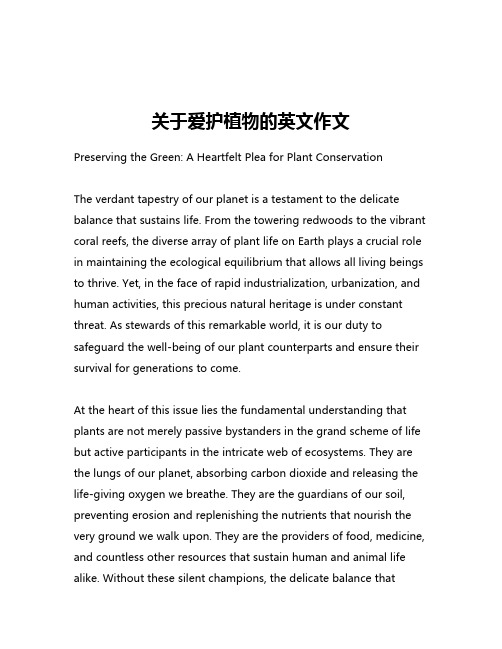
关于爱护植物的英文作文Preserving the Green: A Heartfelt Plea for Plant ConservationThe verdant tapestry of our planet is a testament to the delicate balance that sustains life. From the towering redwoods to the vibrant coral reefs, the diverse array of plant life on Earth plays a crucial role in maintaining the ecological equilibrium that allows all living beings to thrive. Yet, in the face of rapid industrialization, urbanization, and human activities, this precious natural heritage is under constant threat. As stewards of this remarkable world, it is our duty to safeguard the well-being of our plant counterparts and ensure their survival for generations to come.At the heart of this issue lies the fundamental understanding that plants are not merely passive bystanders in the grand scheme of life but active participants in the intricate web of ecosystems. They are the lungs of our planet, absorbing carbon dioxide and releasing the life-giving oxygen we breathe. They are the guardians of our soil, preventing erosion and replenishing the nutrients that nourish the very ground we walk upon. They are the providers of food, medicine, and countless other resources that sustain human and animal life alike. Without these silent champions, the delicate balance thatsustains our world would be irreparably disrupted.Yet, despite their vital importance, plants face a myriad of threats, both natural and human-induced. Deforestation, urbanization, and the expansion of agricultural lands have led to the destruction of vast swaths of natural habitats, robbing countless plant species of their homes and driving them to the brink of extinction. Invasive species, introduced either intentionally or accidentally, can outcompete and displace native flora, disrupting the intricate ecological relationships that have evolved over millennia. Climate change, with its erratic weather patterns and rising temperatures, further exacerbates the challenges faced by vulnerable plant populations, forcing them to adapt or perish in the face of rapidly shifting environmental conditions.To address these pressing concerns, it is imperative that we, as a global community, take decisive action to protect and preserve the plant life that sustains our world. This begins with a fundamental shift in our mindset, recognizing that the well-being of plants is inextricably linked to our own survival and prosperity. We must cultivate a deep appreciation for the invaluable contributions of plants, from their role in regulating the climate to their provision of essential resources and their intrinsic beauty that enriches our lives.One of the most crucial steps we can take is to support and expandconservation efforts. This includes establishing protected areas, such as national parks and nature reserves, where plant species can thrive without the threat of human interference. It also means implementing stringent regulations and enforcement measures to curb deforestation, illegal logging, and the unsustainable exploitation of natural resources. By safeguarding the habitats of endangered plant species, we can ensure their survival and the preservation of the delicate ecosystems they sustain.Additionally, we must invest in research and scientific initiatives that deepen our understanding of plant life and the complex interactions within their environments. This knowledge can inform more effective conservation strategies, as well as guide the development of sustainable agricultural practices and urban planning that minimize the impact on plant communities. By harnessing the power of science and technology, we can develop innovative solutions to protect and restore plant life, ensuring a future where the verdant tapestry of our planet remains vibrant and resilient.At the individual level, we can all play a role in safeguarding the plants that enrich our world. Simple actions, such as planting native species in our gardens, supporting local farmers and community gardens, and reducing our consumption of resources that contribute to deforestation, can have a profound impact. By educating ourselves and our communities about the importance of plantconservation, we can inspire others to join the cause and cultivate a deep respect for the natural world.In the end, the fate of our plant counterparts is inextricably linked to our own. By protecting and nurturing the diverse array of plant life that graces our planet, we are not only preserving the delicate balance of our ecosystems but also safeguarding our own future. It is time to heed the call of the verdant tapestry, to recognize the intrinsic value of plants, and to take decisive action to ensure their survival. For in doing so, we secure the very foundations of life itself, creating a world where the harmony between humanity and nature is celebrated and preserved for generations to come.。
《植物》植物如何保护自己
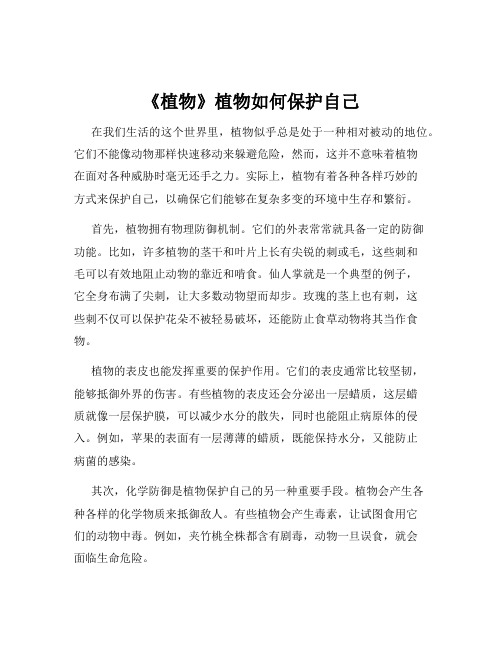
《植物》植物如何保护自己在我们生活的这个世界里,植物似乎总是处于一种相对被动的地位。
它们不能像动物那样快速移动来躲避危险,然而,这并不意味着植物在面对各种威胁时毫无还手之力。
实际上,植物有着各种各样巧妙的方式来保护自己,以确保它们能够在复杂多变的环境中生存和繁衍。
首先,植物拥有物理防御机制。
它们的外表常常就具备一定的防御功能。
比如,许多植物的茎干和叶片上长有尖锐的刺或毛,这些刺和毛可以有效地阻止动物的靠近和啃食。
仙人掌就是一个典型的例子,它全身布满了尖刺,让大多数动物望而却步。
玫瑰的茎上也有刺,这些刺不仅可以保护花朵不被轻易破坏,还能防止食草动物将其当作食物。
植物的表皮也能发挥重要的保护作用。
它们的表皮通常比较坚韧,能够抵御外界的伤害。
有些植物的表皮还会分泌出一层蜡质,这层蜡质就像一层保护膜,可以减少水分的散失,同时也能阻止病原体的侵入。
例如,苹果的表面有一层薄薄的蜡质,既能保持水分,又能防止病菌的感染。
其次,化学防御是植物保护自己的另一种重要手段。
植物会产生各种各样的化学物质来抵御敌人。
有些植物会产生毒素,让试图食用它们的动物中毒。
例如,夹竹桃全株都含有剧毒,动物一旦误食,就会面临生命危险。
还有一些植物会产生特殊的气味来驱赶害虫。
比如,大蒜会散发出一种强烈的气味,这种气味对很多害虫具有驱赶作用。
而薄荷的清凉气味不仅能让人感到舒适,对于一些昆虫来说也是一种“警告”,让它们不敢轻易靠近。
植物在受到侵害时,还能通过释放化学信号来“求救”或“预警”。
当一片叶子被虫子啃食时,它会释放出一些化学物质,这些物质可以传递给周围的植物,让它们提前做好防御准备。
这种神奇的交流方式使得植物群体能够共同应对外界的威胁。
此外,植物还具有巧妙的生长策略来保护自己。
一些植物会通过快速生长来摆脱被侵害的危险。
比如,在春季,野草会迅速生长,抢占空间和资源,使其他竞争植物难以立足。
有些植物还会与其他生物形成共生关系,以获得保护。
保护植物英语作文八年级

保护植物英语作文八年级Protecting Plants: A Crucial Environmental ResponsibilityThe natural world is a delicate and intricate tapestry, woven together by the intricate relationships between various living organisms and their surrounding environments. At the heart of this tapestry lie the plants, which play a vital role in sustaining the balance and health of our ecosystems. As the foundation of the food chain and the primary producers of oxygen, plants are essential to the survival of all life on Earth. However, in the face of increasing human activity and environmental degradation, the need to protect and preserve these valuable resources has never been more urgent.One of the primary reasons for the importance of plant conservation is their role in maintaining the global ecosystem. Plants are the foundation of most terrestrial food webs, providing the primary source of energy and nutrients for a vast array of organisms, from the smallest insects to the largest mammals. Without the presence of healthy, diverse plant life, the entire food chain would collapse, leading to the extinction of countless species and the disruption of the delicate balance that sustains our planet.Moreover, plants are the primary producers of oxygen, a gas essential for the respiration of all aerobic organisms, including humans. Through the process of photosynthesis, plants absorb carbon dioxide and release oxygen, creating a vital cycle that supports the existence of life on Earth. As the global population continues to grow and industrialization expands, the demand for oxygen has increased exponentially, making the protection of plant life a critical concern.In addition to their ecological significance, plants also play a crucial role in regulating the Earth's climate and water cycle. Forests, in particular, act as natural carbon sinks, absorbing and storing vast amounts of atmospheric carbon dioxide, which helps to mitigate the effects of climate change. Furthermore, plants help to stabilize soil, prevent erosion, and regulate the flow of water, ensuring the availability of clean, fresh water for both human and ecological use.Unfortunately, the threats to plant life are numerous and ever-increasing. Deforestation, urbanization, pollution, invasive species, and climate change are just a few of the factors that have contributed to the decline of plant diversity and abundance around the world. As habitats are destroyed and ecosystems are disrupted, many plant species are facing the risk of extinction, with some estimates suggesting that up to a quarter of all plant species could be lost within the next century.To address this critical issue, it is essential that we take immediate and decisive action to protect and conserve plant life. This can be achieved through a multifaceted approach that involves both individual and collective efforts.At the individual level, there are numerous ways in which we can contribute to plant conservation. Simple actions such as planting native species in our gardens, supporting local and organic agriculture, and reducing our carbon footprint can have a significant impact. Additionally, we can educate ourselves and others about the importance of plant conservation, and advocate for stronger environmental policies and regulations that prioritize the protection of plant life.At the societal and governmental level, more comprehensive strategies are necessary to address the complex challenges facing plant ecosystems. This may include the establishment of protected areas, the implementation of sustainable land-use practices, the investment in research and innovation to develop more eco-friendly technologies, and the enforcement of strict regulations to curb activities that threaten plant life.Furthermore, international cooperation and collaboration are essential in addressing the global nature of plant conservation.Initiatives such as the Convention on Biological Diversity and the Intergovernmental Science-Policy Platform on Biodiversity and Ecosystem Services (IPBES) provide frameworks for countries to work together to protect and restore plant diversity on a global scale.In conclusion, the protection of plant life is a crucial environmental responsibility that we all share. By recognizing the vital role that plants play in sustaining the health and balance of our planet, and by taking concrete actions to conserve and restore plant ecosystems, we can ensure that future generations will inherit a world that is rich, diverse, and capable of supporting all forms of life. It is our duty, as stewards of the Earth, to safeguard the plants that sustain us and to pass on a legacy of environmental responsibility to those who will come after us.。
小小绿色使者小学生小品剧本呼吁保护植物和生态环境

小小绿色使者小学生小品剧本呼吁保护植物和生态环境(文章格式:小品剧本)角色:小小绿色使者(绿)小明(明)小红(红)小花(花)小树(树)小草(草)小鸟(鸟)场景一:校园(舞台上装饰有绿树、鲜花和绿色的草地)(绿、明、红手拉着手一起走进校园,绿手拿着一个小绿旗)绿:大家好,我是小小绿色使者,今天我要给大家带来一个小品剧,呼吁大家保护植物和生态环境。
明:小绿,你有什么好办法呢?绿:我们可以从每一个人的身边做起。
首先,我们应该从校园开始,保护校园的绿色环境。
大家都知道,植物是我们生态环境的重要组成部分。
红:是的,没有了树木、花草,地球将变得一片荒凉。
明:那我们应该怎么保护植物呢?绿:首先,不乱扔垃圾,保持环境整洁,这样可以避免垃圾对植物的伤害。
红:其次,要节约用水,水是植物生长所必需的,我们不能浪费它。
明:还有呢?绿:我们还可以每天关心一下植物,给它们浇水、修剪枝叶,让它们茁壮成长。
明:小小绿色使者的提议很好,我们一定要好好保护植物和生态环境。
(众人鼓掌)场景二:小溪边(舞台一侧有一个小溪,另一侧有小鸟在树上)(绿、明、红、花、树、草走到小溪边)绿:我们来到小溪边,小溪中的水是清澈见底的,我们应该一起保护好这份宝贵的水资源。
明:那我们该怎么保护小溪呢?绿:首先,不乱扔垃圾进水里,垃圾会污染水质。
红:其次,要爱护小动物,我们不能抓鱼、抓虾,这样会破坏生态平衡。
花:再次,我们可以种植一些水草,水草可以吸收水中的污染物质,保持水质的清洁。
树:最后,我们还可以组织清洁小溪的活动,定期清理杂草和垃圾。
草:我们一定要用行动守护好小溪,保护好周围的生态环境。
(众人齐声喊口号:“保护小溪,呵护生态!”)场景三:森林(舞台布景变成了茂密的绿色森林)(绿、明、红、花、树、草、鸟走进森林)绿:森林是地球上最宝贵的财富之一,它不仅可以提供给我们氧气,还是许多动植物的家园。
明:可是森林还面临着砍伐和火灾的威胁。
绿:没错,我们应该尽力保护森林,防止破坏和火灾的发生。
幼儿园大班科学优质教案植物的自我保护

幼儿园大班科学优质教案植物自我保护一、教学内容在教学内容安排上,我选取《幼儿园大班科学探究》教材中第四章《植物世界》第一节《植物自我保护》。
本节课将详细讲解植物如何通过不同方式保护自己,如刺、毒、臭味等,以适应复杂多变生活环境。
二、教学目标1. 让幼儿解和掌握植物自我保护方式,提高他们对自然科学兴趣。
2. 培养幼儿观察、思考、表达能力,激发他们探究欲望。
3. 培养幼儿关爱植物、保护环境意识。
三、教学难点与重点1. 教学难点:理解植物自我保护方式及其意义。
2. 教学重点:培养幼儿观察、思考、表达能力。
四、教具与学具准备1. 教具:各种具有自我保护特征植物或图片,如仙人掌、夹竹桃等。
2. 学具:画笔、彩纸、剪刀、胶水等。
五、教学过程1. 实践情景引入:带领幼儿观察校园或附近植物,引导他们关注植物自我保护现象。
2. 例题讲解:a. 展示仙人掌图片,引导幼儿观察其特点,讨论仙人掌如何保护自己。
3. 随堂练习:让幼儿分组讨论,每组选择一种植物,画出它自我保护特征,并分享给全班同学。
六、板书设计1. 植物自我保护2. 内容:a. 仙人掌:刺b. 夹竹桃:毒c. 蒲公英:轻柔种子,随风传播d. 其他植物自我保护方式七、作业设计1. 作业题目:观察身边植物,选择一种具有自我保护特征植物,画出来并简要描述其保护方式。
2. 答案示例:植物名称:玫瑰保护方式:刺描述:玫瑰茎上有许多刺,可以防止动物吃掉它们,保护自己。
八、课后反思及拓展延伸1. 课后反思:通过本节课学习,我发现幼儿对植物自我保护产生浓厚兴趣,观察、思考、表达能力得到提高。
2. 拓展延伸:在下一节课中,我们将进一步探讨植物生长环境,解它们如何适应不同环境,以巩固本节课所学内容。
同时,组织一次户外活动,让幼儿亲身体验植物自我保护现象。
重点和难点解析:1. 教学难点与重点把握。
2. 实践情景引入安排。
3. 例题讲解深入浅出。
4. 作业设计针对性与答案示例引导性。
植物的自我保护和防御机制

2
诱导抗性
当植物受到病原菌攻击时,它们会产生 一系列生化反应,诱导抗性基因的表达 ,从而增强对病原菌的抵抗力。这种抗 性通常具有持久性和广谱性。
3
微生物互作
植物与根际微生物之间存在密切的互作 关系。一些有益微生物可以帮助植物抵 抗病原菌的入侵,促进植物生长和发育 。
基因工程在植物防御中的应用
抗虫基因工程
抵御外来入侵
植物的自我保护和防御机制能够抵御外来物种的入侵,保 护本地生态系统的稳定性和多样性。
感谢您的观看
THANKS
自我保护和防御机制有 助于植物在竞争激烈的 环境中获取更多的资源 和空间,从而促进其生 长和发育。
在农业和园艺中的应用
抗病育种
利用植物的自我保护和防御机制,培育具有抗病性的作物品种, 减少农药使用,提高农产品质量和产量。
生物防治
利用天敌、寄生性昆虫等生物控制方法,增强植物的自我保护和防 御能力,减少害虫和病原体的危害。
03
化学防御机制
毒素和次生代谢物
1 2 3
氰苷
存在于许多植物中,如杏仁、桃子和樱桃等,被 破坏时会释放出氢氰酸,对动物产生毒性。
生物碱
一类含氮的碱性有机化合物,如尼古丁、可卡因 等,具有多种生物活性,对动物产生毒性或药理 作用。
酚类化合物
如单宁、黄酮类化合物等,具有收敛性,能与蛋 白质结合形成不溶性复合物,降低动物的消化率 。
02
物理防御机制
表皮毛和刺
表皮毛
某些植物体表覆盖着密集的表皮 毛,这些细小的毛发可以降低气 温、减少水分蒸发,并有效地阻 挡昆虫和病原体的侵入。
刺
一些植物如仙人掌、玫瑰等,长 有尖锐的刺,可以防止动物啃食 ,降低机械损伤的风险。
植物的自我保护机制

植物的自我保护机制植物作为生命的一部分,需要应对各种外界环境和生物的威胁。
为了保护自身、延续繁衍,植物进化出了许多独特而高效的自我保护机制。
这些机制包括生理反应、化学防御以及结构适应等方面。
本文将详细探讨植物的自我保护机制,揭示植物在面对各种风险时的应对策略。
一、生理反应:调节生长和发育周期植物通过对外界环境的感知和适应,调控生长和发育周期,以达到自我保护的目的。
对于恶劣环境,如干旱、病虫害等,植物可以通过抑制生长、减缓发育速度来降低需求和减少受害的可能性。
同时,植物还能在环境条件改善后,迅速恢复正常的生长和发育状态。
这种生理反应机制,使植物能够在逆境中生存,并在适宜条件下繁衍生息。
二、化学防御:产生抗性物质和毒素植物通过合成和释放特定的化学物质来防御外界的威胁。
一方面,植物可以产生抗性物质,增强自身对病原菌、真菌、昆虫等生物的抵抗能力。
这些抗性物质可以干扰病原菌或虫害的生理功能,阻碍其侵入和繁殖,达到自我保护的目的。
另一方面,植物还可以合成和释放毒素,用以抑制竞争植物的生长和发育。
这些毒素可以通过根系排泄,抑制周围植物的根系生长,降低竞争强度,确保自身的存活和发展。
三、结构适应:厚实表皮和刺毛防御植物的结构适应是它们一种常见的自我保护机制。
许多植物拥有特殊的结构特征,以保护自身免受外界威胁。
例如,一些草原植物拥有厚实而多层的表皮细胞,这种结构可以有效地减少水分蒸发和病原菌的入侵。
此外,某些植物的表面还长有刺毛,可以遏制动物的进食行为,起到防御和保护的作用。
四、共生关系:与其他生物形成互利共生植物为了自身的保护和繁衍,与其他生物形成了互利共生的关系。
最典型的例子是植物与蜜蜂之间的关系。
植物通过花朵产生香气和色彩来吸引蜜蜂,蜜蜂在采食花蜜的过程中,帮助植物传播花粉,实现了双方的利益平衡。
这种共生关系不仅能增加植物繁殖的机会,还能吸引其他有益生物,如天敌和寄生拟态昆虫,帮助防御植物的天敌,提高植物的存活率。
保护动植物就是保护我们自己英语作文

保护动植物就是保护我们自己英语作文全文共3篇示例,供读者参考篇1Protecting wildlife means protecting ourselvesWildlife plays a crucial role in maintaining the balance of our ecosystem. From the tiniest insects to the largest elephants, every living creature is interconnected and dependent on each other for survival. However, due to various human activities such as deforestation, poaching, and pollution, many species are now facing the threat of extinction.Protecting wildlife is not just a moral obligation, but also a matter of self-interest. Here are several reasons why protecting animals and plants is essential for our own well-being:1. Biodiversity conservation: Wildlife conservation is essential for maintaining biodiversity. Biodiversity is the key to a healthy ecosystem as it ensures the stability of different species and their habitats. It provides us with a variety of resources such as food, medicine, and clean water. By protecting wildlife, we are also safeguarding our own resources and ensuring the long-term sustainability of our planet.2. Economic benefits: Wildlife tourism is a significant source of income for many countries. By protecting wildlife and their habitats, we can create opportunities for eco-tourism, which can generate revenue, create jobs, and stimulate local economies. Protecting endangered species such as tigers, elephants, and rhinos can attract tourists and boost the economy of the region.3. Ecological services: Wildlife provides a range of essential ecological services, such as pollination, seed dispersal, and pest control. Many plants and crops depend on animals for pollination, while predators help to control the population of pests. By protecting wildlife, we are ensuring the continuation of these crucial services that are essential for our food security and agricultural productivity.4. Climate change mitigation: Forests and other natural habitats are important carbon sinks that help to absorb greenhouse gases and mitigate climate change. By protecting forests and other wildlife habitats, we are not only preserving biodiversity but also helping to combat climate change. Protecting wildlife is essential for maintaining the balance of our ecosystem and reducing the impact of climate change on our planet.5. Cultural heritage: Wildlife plays a significant role in many cultures and traditions around the world. Many indigenous communities rely on wildlife for their spiritual beliefs, traditional practices, and cultural identity. By protecting wildlife, we are also preserving our cultural heritage and respecting the rights and traditions of these communities.In conclusion, protecting wildlife is not just a moral obligation, but also a matter of self-interest. By protecting animals and plants, we are safeguarding our own resources, ensuring the stability of our ecosystem, and securing our own well-being. It is essential for us to take action now to protect wildlife and preserve the biodiversity of our planet for future generations. We must all work together to protect wildlife and ensure a sustainable future for ourselves and the generations to come.篇2Protecting wildlife means protecting ourselvesAs human beings, we are not the only inhabitants of this planet. There are countless other living creatures that also call Earth their home. From the majestic elephants roaming the savannas of Africa to the delicate flowers blooming in ourgardens, every living being plays a crucial role in maintaining the balance of our ecosystem.However, due to human activities such as deforestation, poaching, pollution, and habitat destruction, many species of animals and plants are facing the threat of extinction. If we continue to exploit and destroy their natural habitats, we are not only endangering the survival of these creatures, but also putting our own future at risk.Protecting wildlife is not just an ethical responsibility, but also a matter of self-preservation. Here are three reasons why conserving our biodiversity is essential for our own well-being:1. Biodiversity supports ecosystem servicesEcosystem services are the benefits that we receive from the natural world, such as clean air, fresh water, fertile soil, and pollination. Biodiversity plays a crucial role in maintaining these services. For example, bees and other pollinators are essential for the reproduction of plants, including many of the crops that we rely on for food. If we lose these pollinators due to habitat loss or pesticide use, our food supply will be severely impacted.2. Biodiversity provides new opportunities for medicine and innovationMany of the plants and animals that are at risk of extinction contain valuable compounds that have the potential to be used in medicine, agriculture, and other industries. By protecting these species, we are not only preserving the potential for new discoveries and innovations, but also ensuring that future generations have access to these resources.3. Biodiversity enriches our livesWildlife and plants are not just resources to be exploited –they also bring beauty, wonder, and inspiration to our lives. Whether it's watching a family of dolphins play in the ocean or admiring a rare orchid in bloom, interacting with nature provides us with a sense of connection and joy that is essential for our mental and emotional well-being.In conclusion, protecting wildlife is not a choice, but a necessity. By conserving our biodiversity, we are not only safeguarding the future of our planet, but also ensuring our own survival and prosperity. It is time for us to take action and prioritize the protection of all living beings, for the benefit of ourselves and future generations. Let's act now, before it's too late.篇3Protecting animals and plants is not only important for the environment, but also crucial for our own well-being. Animals and plants play a vital role in maintaining the balance of ecosystems and providing us with essential resources. Thus, it is essential that we take steps to protect them in order to ensure a sustainable future for ourselves and the planet.One of the main reasons why protecting animals and plants is important is that they contribute to the stability of ecosystems. Each species has a specific role to play in the ecosystem, and if one species is threatened or becomes extinct, it can have a domino effect on the entire ecosystem. For example, bees are important pollinators that help to fertilize plants and crops. Without bees, many plants would not be able to reproduce, leading to a decline in biodiversity and potentially impacting food production. By protecting bees and other pollinators, we are also protecting the plants and crops that we rely on for food.Furthermore, animals and plants provide us with essential resources that are necessary for our survival. For example, many medicines are derived from plant sources, such as theanti-cancer drug taxol, which is derived from the Pacific yew tree. By protecting plant species, we are also protecting potential sources of new medicines that could help to treat a variety ofdiseases. Animals also provide us with important resources, such as food, clothing, and shelter. By protecting animal species, we are ensuring that these resources will be available for future generations.In addition to the practical benefits of protecting animals and plants, there are also ethical reasons to do so. All living beings have intrinsic value and a right to exist, regardless of their utility to humans. By protecting animals and plants, we are showing respect for the diversity of life on Earth and recognizing the interconnectedness of all living beings. It is our responsibility as stewards of the planet to ensure that future generations have the opportunity to experience the beauty and wonder of the natural world.There are several ways that we can work to protect animals and plants. One way is through conservation efforts, such as establishing protected areas and wildlife sanctuaries. These areas provide a safe habitat for endangered species to thrive and help to preserve biodiversity. Another way is through sustainable practices, such as sustainable agriculture and forestry, which minimize the impact on natural habitats and promote thelong-term health of ecosystems. Additionally, educating thepublic about the importance of protecting animals and plants can help to raise awareness and inspire action.Ultimately, protecting animals and plants is not just about saving species from extinction, but about preserving the delicate balance of ecosystems and ensuring a sustainable future for ourselves and future generations. By taking steps to protect animals and plants, we are also protecting our own well-being and the health of the planet. It is up to each of us to take action and make a commitment to conserving the natural world for the benefit of all.。
幼儿园大班科学《植物的自我保护》优质课公开课教案比赛讲课获奖教案
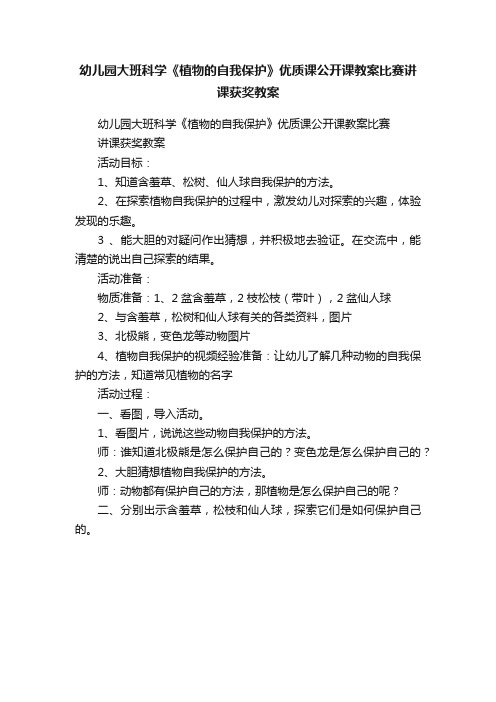
幼儿园大班科学《植物的自我保护》优质课公开课教案比赛讲
课获奖教案
幼儿园大班科学《植物的自我保护》优质课公开课教案比赛
讲课获奖教案
活动目标:
1、知道含羞草、松树、仙人球自我保护的方法。
2、在探索植物自我保护的过程中,激发幼儿对探索的兴趣,体验发现的乐趣。
3 、能大胆的对疑问作出猜想,并积极地去验证。
在交流中,能清楚的说出自己探索的结果。
活动准备:
物质准备:1、2盆含羞草,2枝松枝(带叶),2盆仙人球
2、与含羞草,松树和仙人球有关的各类资料,图片
3、北极熊,变色龙等动物图片
4、植物自我保护的视频经验准备:让幼儿了解几种动物的自我保护的方法,知道常见植物的名字
活动过程:
一、看图,导入活动。
1、看图片,说说这些动物自我保护的方法。
师:谁知道北极熊是怎么保护自己的?变色龙是怎么保护自己的?
2、大胆猜想植物自我保护的方法。
师:动物都有保护自己的方法,那植物是怎么保护自己的呢?
二、分别出示含羞草,松枝和仙人球,探索它们是如何保护自己的。
幼儿园大班科学教案植物的自我保护

幼儿园大班科学教案植物的自我保护一、教学内容本节课选自幼儿园大班科学教材《身边的科学》第四章《植物的世界》第二节《植物的自我保护》。
详细内容主要包括植物在自然界中的生存方式,如何运用各种方式保护自己,如刺、毒性、恶臭等。
二、教学目标1. 让幼儿了解植物生存的环境,知道植物也有自我保护的能力。
2. 培养幼儿观察、思考、表达的能力,激发他们对科学的兴趣。
3. 培养幼儿关爱大自然、保护植物的意识。
三、教学难点与重点教学难点:理解植物自我保护的方式和原理。
教学重点:培养幼儿观察、思考和表达能力。
四、教具与学具准备教具:实物植物(如仙人掌、夹竹桃等)、图片、PPT等。
学具:画笔、画纸、放大镜等。
五、教学过程1. 实践情景引入展示仙人掌、夹竹桃等具有自我保护特性的植物,让幼儿观察并发表自己的看法。
2. 例题讲解(1)介绍仙人掌的刺是如何保护自己的。
(2)讲解夹竹桃的毒性是如何避免被动物吃掉。
3. 随堂练习请幼儿用放大镜观察周围的植物,找出具有自我保护特性的植物,并尝试解释其原理。
4. 分组讨论(1)为什么植物需要自我保护?(2)你还知道哪些植物的自我保护方式?六、板书设计1. 植物的自我保护刺:仙人掌毒性:夹竹桃恶臭:大蒜2. 幼儿观察到的其他植物自我保护方式七、作业设计1. 作业题目:观察身边的植物,找出具有自我保护特性的植物,并描述其保护方式。
答案示例:我观察到的植物是玫瑰。
它的自我保护方式是刺。
玫瑰的刺可以避免被动物吃掉,保护自己的生命。
2. 画一画你最喜欢的植物,并注明其自我保护方式。
八、课后反思及拓展延伸1. 课后反思本节课通过实物展示、讲解、讨论等方式,让幼儿了解了植物的自我保护特性。
在课后,教师应关注幼儿对植物自我保护的理解程度,及时解答他们的疑问。
2. 拓展延伸(1)组织幼儿去植物园实地观察,了解更多植物的自我保护方式。
(2)开展“我心中的植物”主题活动,让幼儿用绘画、手工等形式表达对植物的关爱。
植物自我保护的方法
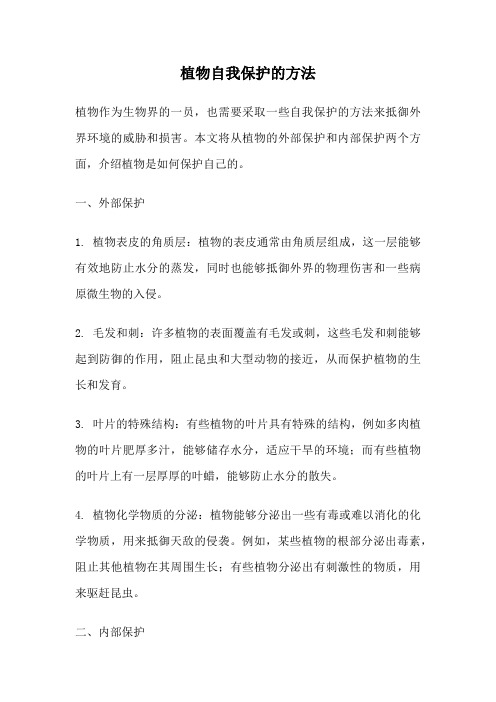
植物自我保护的方法植物作为生物界的一员,也需要采取一些自我保护的方法来抵御外界环境的威胁和损害。
本文将从植物的外部保护和内部保护两个方面,介绍植物是如何保护自己的。
一、外部保护1. 植物表皮的角质层:植物的表皮通常由角质层组成,这一层能够有效地防止水分的蒸发,同时也能够抵御外界的物理伤害和一些病原微生物的入侵。
2. 毛发和刺:许多植物的表面覆盖有毛发或刺,这些毛发和刺能够起到防御的作用,阻止昆虫和大型动物的接近,从而保护植物的生长和发育。
3. 叶片的特殊结构:有些植物的叶片具有特殊的结构,例如多肉植物的叶片肥厚多汁,能够储存水分,适应干旱的环境;而有些植物的叶片上有一层厚厚的叶蜡,能够防止水分的散失。
4. 植物化学物质的分泌:植物能够分泌出一些有毒或难以消化的化学物质,用来抵御天敌的侵袭。
例如,某些植物的根部分泌出毒素,阻止其他植物在其周围生长;有些植物分泌出有刺激性的物质,用来驱赶昆虫。
二、内部保护1. 植物光合作用:植物通过光合作用将阳光能转化为化学能,生产出有机物质,为自己提供能量和养分。
光合作用不仅能满足植物的生长需求,还能产生氧气,为其他生物提供氧气。
2. 抗氧化系统:植物细胞会产生一些有害的氧自由基,这些氧自由基会对细胞的结构和功能造成损害。
为了保护自己,植物会产生一系列的抗氧化酶和物质来清除这些有害物质,维护细胞的正常功能。
3. 植物抗病机制:植物能够通过激活自身的抗病机制来抵御病原微生物的侵害。
当植物受到病原微生物的攻击时,会产生一系列的抗病物质,如抗菌肽和抗氧化物质,来杀死病原微生物或减轻病害的程度。
4. 植物生长调节物质:植物能够产生一些生长调节物质来调控自身的生长和发育。
例如,植物激素能够控制植物的开花、果实成熟等过程,使植物能够适应外界环境的变化。
总结起来,植物通过外部保护和内部保护两个方面来保护自己。
外部保护主要包括表皮的角质层、毛发和刺、特殊叶片的结构以及植物化学物质的分泌;内部保护主要包括光合作用、抗氧化系统、植物抗病机制和植物生长调节物质的作用。
植物自我保护的方法
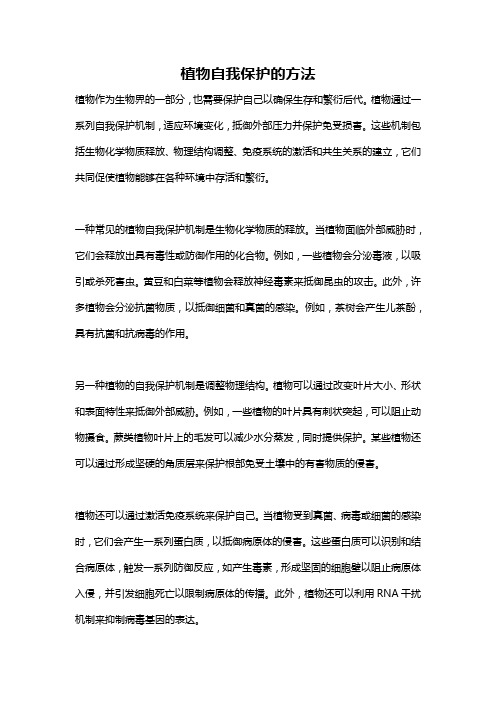
植物自我保护的方法植物作为生物界的一部分,也需要保护自己以确保生存和繁衍后代。
植物通过一系列自我保护机制,适应环境变化,抵御外部压力并保护免受损害。
这些机制包括生物化学物质释放、物理结构调整、免疫系统的激活和共生关系的建立,它们共同促使植物能够在各种环境中存活和繁衍。
一种常见的植物自我保护机制是生物化学物质的释放。
当植物面临外部威胁时,它们会释放出具有毒性或防御作用的化合物。
例如,一些植物会分泌毒液,以吸引或杀死害虫。
黄豆和白菜等植物会释放神经毒素来抵御昆虫的攻击。
此外,许多植物会分泌抗菌物质,以抵御细菌和真菌的感染。
例如,茶树会产生儿茶酚,具有抗菌和抗病毒的作用。
另一种植物的自我保护机制是调整物理结构。
植物可以通过改变叶片大小、形状和表面特性来抵御外部威胁。
例如,一些植物的叶片具有刺状突起,可以阻止动物摄食。
蕨类植物叶片上的毛发可以减少水分蒸发,同时提供保护。
某些植物还可以通过形成坚硬的角质层来保护根部免受土壤中的有害物质的侵害。
植物还可以通过激活免疫系统来保护自己。
当植物受到真菌、病毒或细菌的感染时,它们会产生一系列蛋白质,以抵御病原体的侵害。
这些蛋白质可以识别和结合病原体,触发一系列防御反应,如产生毒素,形成坚固的细胞壁以阻止病原体入侵,并引发细胞死亡以限制病原体的传播。
此外,植物还可以利用RNA干扰机制来抑制病毒基因的表达。
共生关系也是植物自我保护的重要方式。
植物可以与其他生物建立互惠关系,以提供保护和营养。
例如,黄瓜和豆科植物会与霉菌建立共生关系,植物提供营养物质,霉菌则提供抵抗病毒的防御机制。
还有一些植物和昆虫之间建立共生关系,昆虫为植物提供授粉,并帮助植物抵御害虫侵袭。
总的来说,植物通过生物化学物质释放、物理结构调整、免疫系统的激活和共生关系的建立等多种方式,保护自己免受外界威胁。
这些自我保护机制使植物能够适应各种环境和生存条件,并确保它们能够繁衍后代。
植物的自我保护机制不仅对于植物本身的生存至关重要,还对维持生态平衡和人类的生存也起到重要作用。
植物如何自我保护英语作文
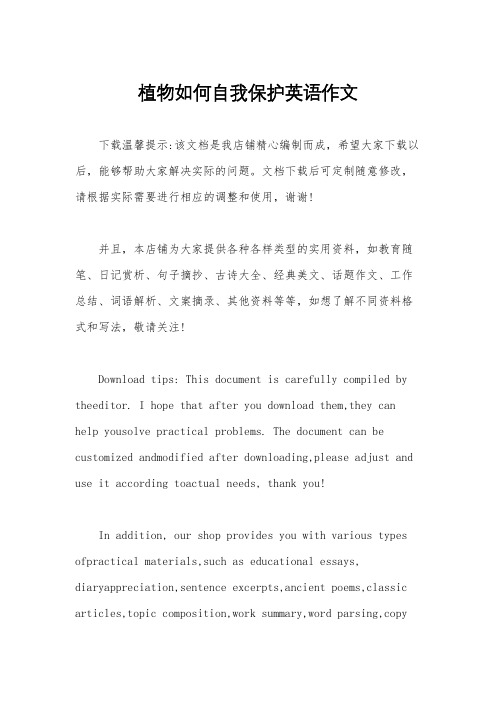
植物如何自我保护英语作文下载温馨提示:该文档是我店铺精心编制而成,希望大家下载以后,能够帮助大家解决实际的问题。
文档下载后可定制随意修改,请根据实际需要进行相应的调整和使用,谢谢!并且,本店铺为大家提供各种各样类型的实用资料,如教育随笔、日记赏析、句子摘抄、古诗大全、经典美文、话题作文、工作总结、词语解析、文案摘录、其他资料等等,如想了解不同资料格式和写法,敬请关注!Download tips: This document is carefully compiled by theeditor. I hope that after you download them,they can help yousolve practical problems. The document can be customized andmodified after downloading,please adjust and use it according toactual needs, thank you!In addition, our shop provides you with various types ofpractical materials,such as educational essays, diaryappreciation,sentence excerpts,ancient poems,classic articles,topic composition,work summary,word parsing,copyexcerpts,other materials and so on,want to know different data formats andwriting methods,please pay attention!Plants have fascinating ways to protect themselves.They have developed various strategies to defend against threats and ensure their survival. Let's explore some of these mechanisms.One way plants protect themselves is through physical barriers. For example, some plants have thorns or spines on their stems or leaves. These sharp structures deter animals from eating them or coming too close. Other plants have tough, waxy coatings on their leaves that prevent waterloss and protect against harmful insects and pathogens.Plants also use chemical defenses to ward off predators. They produce toxic compounds that make them unpalatable or even poisonous. For instance, the leaves of the Oleander plant contain a toxic compound called oleandrin, which can be deadly if ingested. By producing such chemicals, plants ensure that they are not an attractive food source for herbivores.In addition to physical and chemical defenses, plants have evolved behavioral adaptations to protect themselves. Some plants have the ability to mimic their surroundings to avoid being detected by predators. For example, the Malaysian orchid, Bulbophyllum nocturnum, releases a scent that resembles rotting flesh to attract flies for pollination. This scent also attracts carrion-eating beetles, which become potential predators of the orchid's herbivorous enemies.Plants also have the ability to communicate with each other to warn of impending danger. When a plant is attacked by insects, it releases chemical signals into the air that can be detected by neighboring plants. In response, these neighboring plants may produce chemicals that make them less attractive to the insects or activate their own defense mechanisms. This communication between plants, known as "plant-plant signaling," helps them collectively defend against threats.Furthermore, some plants have developed mutualisticrelationships with animals for protection. For example, certain species of ants live in symbiosis with acacia trees. The ants protect the trees from herbivores by aggressively attacking any animal that comes near. In return, the acacia trees provide food and shelter for the ants. This mutually beneficial relationship ensures the survival of both parties.In conclusion, plants have evolved a range offascinating strategies to protect themselves. From physical barriers to chemical defenses, behavioral adaptations to communication, and even mutualistic relationships, plants have developed a diverse array of mechanisms to ensuretheir survival in the face of threats.。
我是植物小保镖作文300字
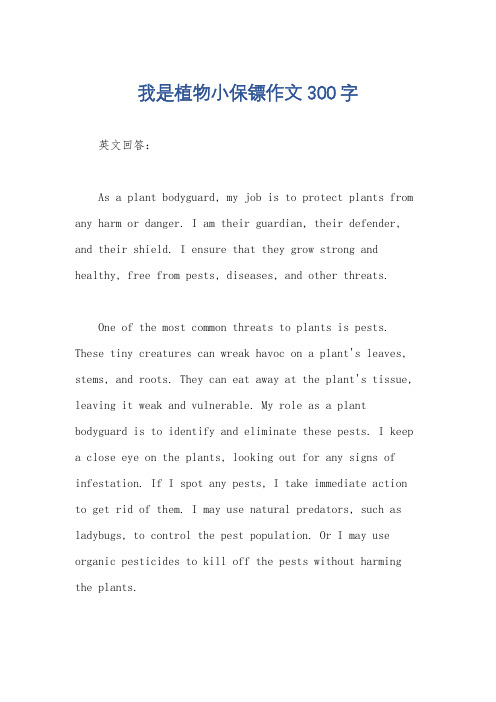
我是植物小保镖作文300字英文回答:As a plant bodyguard, my job is to protect plants from any harm or danger. I am their guardian, their defender, and their shield. I ensure that they grow strong and healthy, free from pests, diseases, and other threats.One of the most common threats to plants is pests. These tiny creatures can wreak havoc on a plant's leaves, stems, and roots. They can eat away at the plant's tissue, leaving it weak and vulnerable. My role as a plant bodyguard is to identify and eliminate these pests. I keep a close eye on the plants, looking out for any signs of infestation. If I spot any pests, I take immediate action to get rid of them. I may use natural predators, such as ladybugs, to control the pest population. Or I may use organic pesticides to kill off the pests without harming the plants.Another threat to plants is diseases. Just like humans, plants can get sick too. They can be infected by bacteria, fungi, or viruses, which can cause them to wither and die. It is my duty to prevent and control these diseases. I make sure that the plants are well-nourished and properly cared for. I provide them with the right amount of water, sunlight, and nutrients. I also keep the plants clean and free from any debris that could harbor disease-causing organisms. If a plant does get sick, I take immediate action to treat it. I may use organic fungicides or bactericides to kill off the disease-causing organisms and help the plant recover.In addition to pests and diseases, plants also face other threats, such as extreme weather conditions and human activities. For example, a plant may be exposed to excessive heat or cold, which can damage its cells and tissues. It may also be subjected to pollution or toxic chemicals, which can harm its growth and development. As a plant bodyguard, I take measures to protect the plants from these threats. I may use shade cloth or mulch to regulate the temperature around the plants. I may also create abarrier or fence to keep humans and animals away from the plants.中文回答:作为植物的小保镖,我的工作是保护植物免受任何伤害和危险。
植物保护专业英语【范本模板】
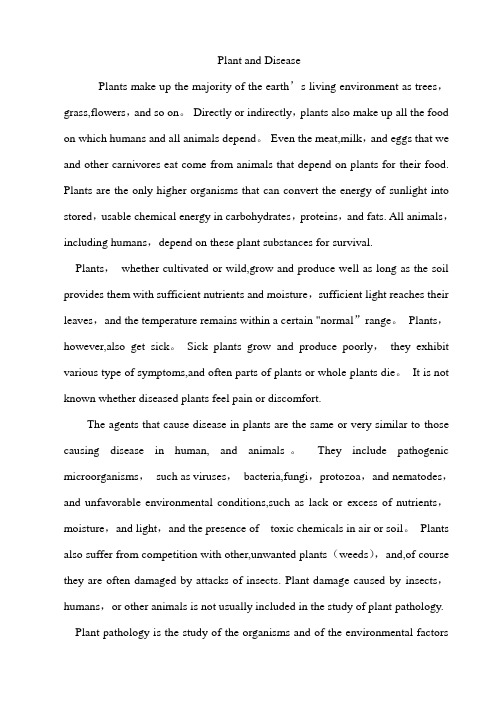
Plant and DiseasePlants make up the majority of the earth’s living environment as trees,grass,flowers,and so on。
Directly or indirectly,plants also make up all the food on which humans and all animals depend。
Even the meat,milk,and eggs that we and other carnivores eat come from animals that depend on plants for their food. Plants are the only higher organisms that can convert the energy of sunlight into stored,usable chemical energy in carbohydrates,proteins,and fats. All animals,including humans,depend on these plant substances for survival.Plants,whether cultivated or wild,grow and produce well as long as the soil provides them with sufficient nutrients and moisture,sufficient light reaches their leaves,and the temperature remains within a certain "normal”range。
Plants,however,also get sick。
Sick plants grow and produce poorly,they exhibit various type of symptoms,and often parts of plants or whole plants die。
植物的自我保护幼儿园教案

植物的自我保护幼儿园教案教案概述本教案旨在通过幼儿园的教导,让幼儿了解植物的自我保护机制。
通过观察和实践,培养幼儿的观察能力和动手能力,让他们在玩乐中学习,提高他们对植物世界的认识。
教案目标通过本教案的学习,幼儿将能够: - 了解植物的自我保护机制; - 掌握植物的一些基本防御方法; - 培养观察和实践能力; - 增强幼儿对植物的兴趣。
教学准备•小绿植苗2-3盆•塑料袋或玻璃罩子•喷雾瓶•半透明纸张•彩色纸、剪刀、胶水等•幼儿园的室内或室外空间教学内容及步骤1. 植物的自我保护介绍(10分钟)•向幼儿们简单介绍植物并告诉他们植物在自然界中也需要自我保护;•小区试种小苗提问方式:“你们注意到了吗?幼苗上的叶子是很嫩的,很容易被风吹折断,所以我们需要给它们一些保护。
”•引导幼儿讨论植物的自我保护方法。
2. 观察植物的自我保护方法(15分钟)•将小绿植苗放置于室内或室外环境中;•引导幼儿仔细观察植物的叶子、茎等部分;•给每个幼儿一个半透明纸张,让他们用纸张观察植物。
3. 制作植物防护器材(30分钟)•将小组的幼儿坐在一起,分配彩色纸、剪刀和胶水等材料;•引导他们思考并制作各种植物防护器材,如刺绣纸叶子、塑料袋保护、玻璃罩子等;•鼓励幼儿们自由发挥创造力,制作出个性化的植物防护器材。
4. 应用植物防护器材(15分钟)•将小组的幼儿分别带到室内或室外观察所种植的小绿植苗;•每个小组选择一种防护器材,将其运用到植物身上;•幼儿们观察并记录下植物的变化。
5. 总结与分享(10分钟)•引导幼儿讨论他们在观察中发现的植物自我保护机制;•鼓励幼儿们分享自己制作的植物防护器材和它们的作用。
教学评估•观察幼儿们在制作植物防护器材时的动手能力和创造力;•细致观察幼儿们在观察植物自我保护时的表现;•打分记录及评估。
教学延伸•接触更多的植物,了解它们的不同特点;•利用幼儿园的园艺活动,培养幼儿的园艺兴趣;•引导幼儿们观察不同季节植物的变化。
- 1、下载文档前请自行甄别文档内容的完整性,平台不提供额外的编辑、内容补充、找答案等附加服务。
- 2、"仅部分预览"的文档,不可在线预览部分如存在完整性等问题,可反馈申请退款(可完整预览的文档不适用该条件!)。
- 3、如文档侵犯您的权益,请联系客服反馈,我们会尽快为您处理(人工客服工作时间:9:00-18:30)。
We’re strong enough to live a happy life.
Plants are not helpless!
Plants are not weak!
We must care for the plants and stop hurting them!
All
Love plants, love yourself!
Plant God
Ok, I will grant your prayer.
Garlic
Plant God! I’m garlic.Please, give me a hot and spicy smell, so the bugs will go away.
Plant God
Ok, I will grant your prayer.
Garlic
I’m garlic. I can kill germs.
Sundew plant
I’m a sundew plant. If you fall down and hurt yourself, I can help you.
All
But we’re very week!
Rose
People pick us!
Grass
Plant God!I’mgrass.Please, give me sharp leaves. Then if bugs touch me, I can cut them.
Plant God
Ok, I will grant your prayer.
Nettle
Plant God! Plant God! I’m a nettle. Please paint poison on my hair so rabbits cannot eat me!
Sundew plant
Plant God, please paint sticky liquid on my leaves,so bugs can not run away, and I can eat them!
Plant God
Ok, I will grant your prayer.
All
Now we all have a special power to protect ourselves.
Nettle
But what can we do?
Rose
I wish there were a God who could protect us!
All
Plant God! Plant God! Please protect us!
Plant God
I want to help you, but you’re too weak. I don’t know what to do. How can I help you?
Nettle
Animals step on us!
Grass
They also eat us!
Garlic
If animals and people keep picking and eating us, we’ll all die!
Sundew plant
I can not stand it any more!
Script: The Plants’ Defense
Class 5 Grade yone likes to see me.
Grass
I’m grass. Cows and horses eat me.
Nettle
I’m a nettle. People use me to make clothes.
Rose
Plant God, I’m a rose. People always pick me because I’m beautiful. Please, give me thorns so people will not pick me.
Plant God
Ok, I will grant your prayer.
